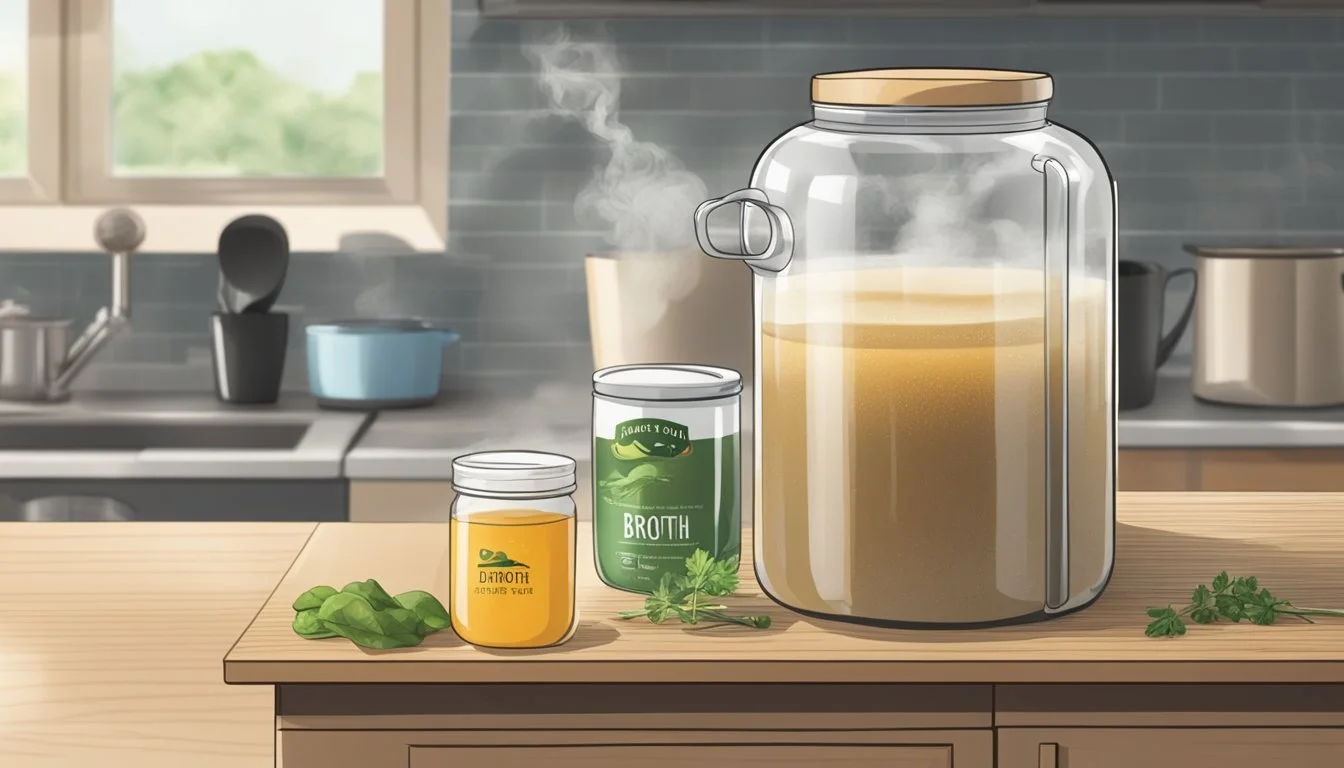Does Bone Broth Spoil?
Essential Facts and Tips
Bone broth, known for its rich flavor and numerous health benefits, is a popular addition to soups, sauces, and various culinary dishes. While it offers nutritional advantages, the question of whether bone broth can spoil is crucial for those who prepare it at home or purchase it from stores. Bone broth does spoil, typically lasting 4 to 7 days in the refrigerator if stored properly in an airtight container.
Recognizing the signs of spoilage is essential to ensure the broth's quality and safety. A sour or off smell is a clear indicator that the bone broth has gone bad. Discard any broth if the container is bulging, leaking, or if the seal is compromised. Unopened, store-bought bone broth can last much longer, up to several months or even years, provided the container remains intact and is stored in a cool, dry place.
Ultimately, whether you're making homemade bone broth or using a store-bought version, proper storage and attention to signs of spoilage are key. Understanding how to keep your bone broth fresh will not only enhance the flavor of your dishes but also maintain its nutritional integrity.
Understanding Bone Broth
Bone broth is a nutrient-rich liquid made by simmering animal bones, connective tissue, and sometimes meat, along with vegetables and seasonings. It serves not only as a flavorful base for soups and sauces but also offers various health benefits, such as supporting gut health and the immune system.
Composition
Bone broth primarily consists of animal bones (chicken, beef, fish, pork) and connective tissue. These are simmered for an extended period, often 12-48 hours, to extract nutrients.
The liquid may also contain meat scraps and vegetables like carrots, onions, and celery. Prolonged simmering releases gelatin from the connective tissue, which gives bone broth its characteristic texture.
Nutritional Value
Bone broth is rich in essential nutrients. It contains amino acids like glycine and proline, which support various bodily functions.
Minerals such as calcium, magnesium, and phosphorus are prominent, supporting bone health. Additionally, bone broth offers small amounts of proteins and gelatin, which promote joint health and skin elasticity.
Benefits for Gut Health and Immune System
Bone broth has benefits for gut health due to the presence of gelatin and amino acids that strengthen the intestinal lining. This can prevent leaky gut syndrome and improve digestion.
The broth also contains compounds that may boost the immune system. Nutrients extracted from bones and connective tissues help in the production of white blood cells.
Varieties of Bone Broth
Different types of bone broth are made using various animal bones. Chicken broth is mild and suitable for soups.
Beef broth has a richer flavor and is darker in color. Fish broth is lighter and faster to prepare, while pork broth has a distinct taste, often used in Asian cuisines. Each variety brings unique flavors and nutrient profiles to dishes.
Storage Fundamentals
Properly storing bone broth ensures it remains fresh and safe to consume. Key factors include choosing the right container, maintaining appropriate temperatures, and understanding shelf life.
Proper Storage Conditions
Bone broth should be stored in a cool and dry place. For short-term storage, a refrigerator set at 40°F (4°C) or lower is ideal.
For long-term storage, freezing is recommended. Use freezer-safe containers or ice cube trays to portion out the broth, leaving space for expansion. Proper labeling with the storage date is also essential to keep track of freshness.
Container Selection
Selecting the right container is crucial for preserving the bone broth's quality.
Airtight containers are the best option to prevent contamination and moisture loss. Glass jars with tightly sealing lids or heat-resistant plastic containers work well for refrigeration. For freezing, sturdy, freezer-safe containers are advisable.
Avoid using containers that might crack or leak, as this can compromise both the safety and flavor of the broth.
Importance of Temperature Control
Maintaining the correct temperature is vital to prevent spoilage.
In the refrigerator, bone broth should be kept at or below 40°F (4°C). This inhibits bacterial growth and extends its shelf life. When using the freezer, the temperature should be 0°F (-18°C) or lower.
Rapid cooling before refrigerating or freezing helps preserve the broth's nutritional value and taste. An ice bath can be useful for quickly lowering the broth's temperature before storage.
Shelf Life Expectancy
The shelf life of bone broth varies based on the storage method.
In the refrigerator, it typically lasts 3-4 days. When properly frozen, the broth can last several months without significant loss of flavor or nutrients. Commercially packaged broths have a longer shelf life—up to two years—if the packaging remains intact.
Always check for signs of spoilage, such as changes in smell, taste, or container integrity, before consuming stored bone broth.
Recognizing Spoilage
Recognizing spoilage in bone broth involves examining several aspects such as odor, taste, texture, and appearance. Understanding these signs and the factors contributing to spoilage can help in maintaining the quality and safety of bone broth.
Signs of Bad Broth
Odor: A fresh bone broth has a rich, savory aroma. If the broth smells sour or unpleasant, it is likely spoiled. Odor is one of the most reliable indicators.
Taste: Spoiled bone broth will have an off-taste. It will not taste as rich or savory as fresh broth. If it tastes sour or otherwise unpalatable, discard it.
Texture: Though texture changes are less common, sometimes spoiled broth can appear slimy. Any unusual texture indicates spoilage.
Appearance: Examine the broth for any changes in color or clarity. Spoiled broth may turn cloudy or have mold growing on the surface. Always look for visual signs.
Factors Contributing to Spoilage
Air Exposure: When bone broth is exposed to air, it is more likely to spoil. This is because bacteria and other microorganisms can easily contaminate it. Always store bone broth in an airtight container.
Storage Temperature: Proper refrigeration is crucial. Bone broth should be stored at a temperature below 40°F (4°C) to prevent bacterial growth. If left out in warm temperatures, it can spoil quickly.
Container Integrity: Ensure that cans or boxes are not bulging, leaking, or compromised. A broken seal can lead to quicker spoilage. Always check the packaging before using.
Expiration Date: Respect the expiration date provided by the manufacturer. Even if the broth looks and smells fine, consuming it past its expiration date carries a risk of food poisoning.
Effects of Oxidation and Bacterial Growth
Oxidation: Exposure to oxygen can result in the oxidation of fats in the broth, leading to rancidity. This not only affects the taste but can also make the broth unsafe to consume. Keeping the broth sealed minimizes this risk.
Bacterial Growth: Bacteria thrive in environments that are warm and nutrient-rich, like bone broth. Storing broth improperly can lead to rapid bacterial growth. This increases the risk of food poisoning.
Signs: Look for signs like a slimy texture, bad smell, and sour taste, which indicate bacterial contamination. It's essential to avoid consuming any broth that shows these signs.
Preservation Techniques
To ensure bone broth stays fresh and safe to consume, specific preservation methods can be used. These methods include freezing, choosing the right packaging, and appropriate thawing and reheating techniques.
Freezing and Its Advantages
Freezing bone broth significantly extends its shelf life. Homemade bone broth and store-bought bone broth can be frozen to preserve their quality for several months.
When frozen, bone broth can last up to six months without losing its flavor or nutritional value. This method prevents spoilage and eliminates concerns about bacterial growth that can occur at refrigerated temperatures.
Cool the broth to room temperature before freezing to maintain its integrity. Avoid freezing large portions, as they are more difficult to thaw and can result in uneven reheating.
Packaging for Freezing
Proper packaging is crucial to avoid freezer burn and ensure broth quality. Freezer bags, glass jars, and plastic containers are all effective. Divide the broth into smaller portions for convenience.
When using freezer bags, leave some space at the top for expansion as the liquid freezes. If using glass jars, choosing jars specifically designed for freezing prevents shattering.
Label each package with the date to track storage time. Vacuum-sealed bags can also be employed to further reduce air contact, enhancing the preservation effect.
Thawing and Reheating
Thawing frozen bone broth correctly is essential for food safety. Reheat it slowly to preserve its nutrients and taste. The ideal way to thaw is to move the broth from the freezer to the refrigerator for 24-48 hours.
For faster thawing, place the sealed container in a bowl of cold water. After thawing, heat the broth on the stove over low heat.
Avoid microwaving, as it can cause uneven heating and negatively affect the broth's quality. Once reheated, the broth should be consumed quickly to prevent spoilage.
Using Bone Broth
Bone broth can enhance various dishes with its rich flavor and is nutritious due to its high protein and collagen content. Adjusting its consistency and flavor to suit specific recipes can elevate your culinary creations.
Incorporating into Recipes
Bone broth serves as a versatile base for many soups and stews, providing a flavorful and nutritious foundation. Common examples include chicken soup, beef stew, and vegetable soup. Adding bone broth to risotto or gravy can impart a deeper, richer flavor.
For a comforting drink, sip bone broth straight from a mug, optionally seasoning with salt, spices, or herbs. Incorporate it into sauces and gravies, where its gelatin content can thicken and add a mouth-watering body to the dish.
Adjusting Consistency and Flavor
To adjust the consistency, simmer the broth longer to reduce and thicken it, or add water to dilute it. Skim off excess fat accumulation on the surface for a clearer broth. Mixing in vegetables during simmering can naturally thicken and enrich the flavor further.
Enhancing flavor involves seasoning with salt, spices, and herbs. Rosemary, thyme, and garlic are popular choices. It's important to season gradually, tasting to avoid overpowering the dish. If the broth's flavor is too intense, mix in water or another liquid like stock to mellow it out.
Advanced Tips for Bone Broth Storage
Proper storage of bone broth can significantly extend its freshness and maintain its nutrient-dense qualities. Effective methods include freezing in small portions, utilizing airtight containers, and being aware of common mistakes.
Maximizing Freshness and Nutrient Retention
To maintain freshness and nutrient integrity, bone broth should be cooled swiftly after preparation. Allow it to come to room temperature before storing.
Store the broth in airtight containers to prevent any contaminants from entering. For freezing, glass jars, freezer-safe bags, and vacuum-sealed bags are ideal. When using glass jars, leave space to allow for expansion to prevent cracking. Use ice cube trays to freeze in smaller, manageable portions. Each cube can be popped out and used as needed, reducing waste.
Avoiding Common Mistakes
It's crucial to avoid common storage mistakes that can compromise the broth's quality. Never store hot broth directly in the freezer; rapid temperature changes can cause glass containers to shatter and plastic containers to warp. Always allow it to cool first.
Do not store bone broth in partially sealed containers as this can lead to contamination. Avoid boiling the broth during reheating; instead, gently warm it on the stovetop to maintain its nutrient content and flavor. Regularly check stored broth for cloudiness, sour smell, or changed texture, all indicators of spoilage.
Utilizing Smaller Portions for Convenience
Splitting bone broth into smaller portions can be highly convenient. Ice cube trays are excellent tools for this. Pour the broth into ice cube trays and freeze. Once frozen, transfer the cubes to a freezer-safe bag for easy access. This method prevents the need to thaw and refreeze large quantities, which can deteriorate its consistency and quality.
Each cube can be reheated individually, reducing waste and ensuring the freshest flavor and maximum nutrient retention. This method also allows for easy measuring, making it simple to add precise amounts to recipes or use as a quick, nutritious drink.







